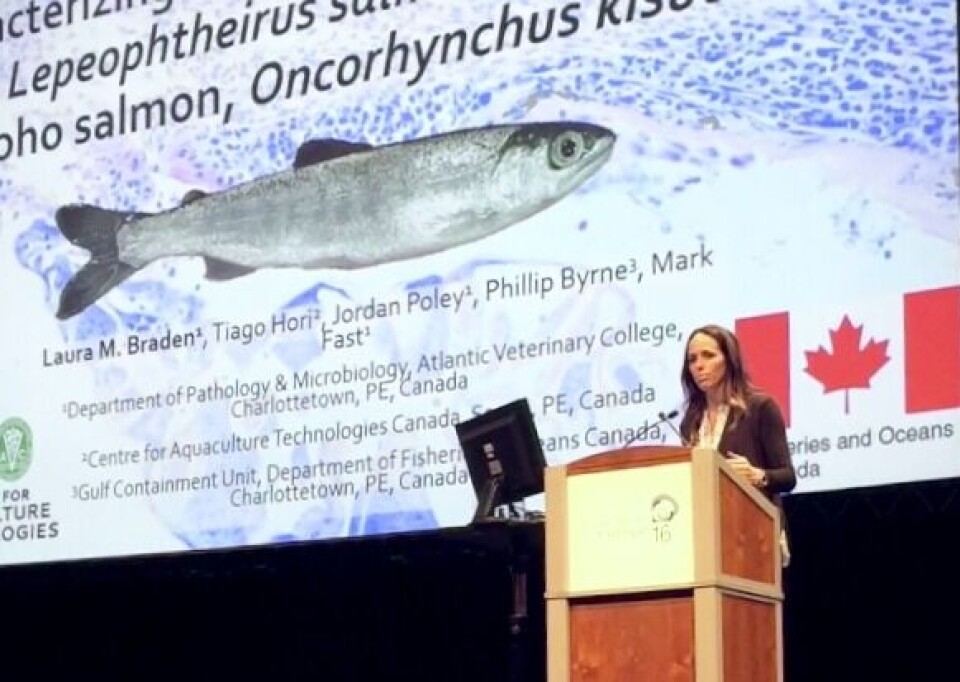
Louse resistance revealed
A team of researchers on Prince Edward Island are mapping the pathways of lice resistance in a project that could "shift the paradigm for Atlantic salmon and aquaculture".
The Atlantic Veterinary College, Department of Fisheries & Oceans, and the Centre for Aquaculture Technologies have teamed up to try and find out why some species of salmon are resistant to sea lice.
Dr Laura Braden, a post-doctoral fellow in the Pathology & Microbiology Department at the Atlantic Veterinary College and the lead researcher on the project, believes understanding how resistant salmon respond to the problematic parasite will help develop novel treatment strategies.
“For Atlantic salmon, lice infection can cause considerable damage to the skin, which leads to many issues, including secondary disease,” Braden said. “But we don’t see the same response in resistant species.”
Braden explained how some species of Pacific salmon, such as coho, are known to rapidly reject the lice days after infection. Earlier research showed this rejection was accompanied by the host skin tissue engulfing the parasite, but the molecular mechanism behind this response has never been characterized.
Dr Mark Fast, Associate Professor at the AVC and the Principal Investigator of the project, said: "Its a really interesting life history and developmental question. Coho salmon are quite unique in this way, but they appear to be able to respond similarly to other ectoparasitic copepod species, as they effectively deal with Caligus rogercresseyi infection in Chile, and C. clemesii in BC."
Now, the team are attempting to identify the pathways involved in the resistant response of coho.
"There are few if any drugs that have shown the type of efficacy at reducing lice infection that coho salmon does. For that reason, truly understanding the innate difference in this host-parasite relationship could totally shift the paradigm for Atlantic salmon and aquaculture," said Fast.
Presenting at the Aquaculture Europe 2016 conference in Edinburgh as well as the 11th International Sea Lice Conference in Westport Ireland, Braden revealed preliminary data demonstrating how juvenile Pacific coho salmon exposed to salmon lice are able to rapidly reject the parasite, with virtually no lice remaining on the fish after 10 days.
And their results suggest that the fish do not simply reject the louse, but actually might be killing them.

Using a new technique, the team is analyzing the genetic response of both the coho and the louse simultaneously – known as “dual RNA-sequencing”, this tool is revolutionizing how scientists investigate relationships between hosts and pathogens.
“Many exciting new projects are using dual RNA-sequencing to investigate host-pathogen interactions, and the results are totally amazing,” Braden told Fish Farming Expert.
“Instead of looking only at the response of the host or pathogen, with this method, we can look at the interactions between the two at the exact same time,” she said.
"Dual RNA-sequencing fully harnesses the power of the next-generation sequencing technologies and the large amount of data they generate. This approach, never before used in sea lice research, allows us to correlate changes happening in the parasite and host, which may reveal the mechanism of rejection," said Dr Tiago Hori, Associate Director of Genomics at the Centre for Aquaculture Technologies and study co-author.
When it comes to the salmon lice, understanding how resistant species like coho salmon are able to rapidly reject the parasite will be invaluable for developing novel control strategies.
“Our results indicate that, within only a few days after infection, there is massive up-regulation of several critical immune pathways that are effectively encapsulating the attached lice and killing them,” Braden explained. “And at the same time, the louse is responding to this attack by launching defense and stress-associated pathways.”
But the lice rarely survive the attack. According to Braden, after infecting hundreds of fish with thousands of larval lice, only a handful of lice make it to the pre-adult stage.
“It is absolutely incredible, these fish are very small and we challenge them with a lot of lice, but it doesn’t matter. Whatever mechanism is responsible for this response is extremely effective.”























































